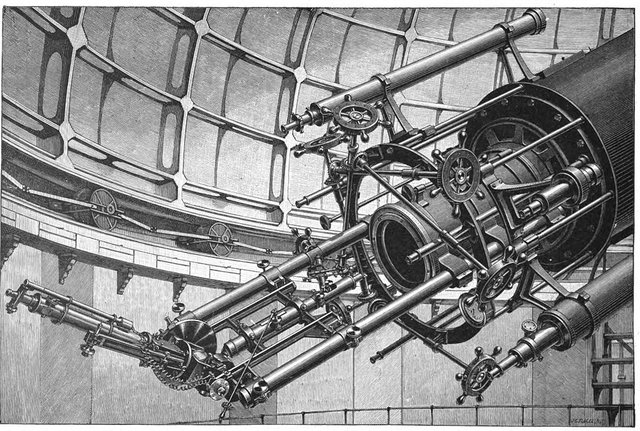Astronomy of the nineteenth century
Before the nineteenth century, astronomers didn't really know what the stars and planets were made of. To get out of mind, astronomy had to connect with physics.

By Herschel, John, (1792 - 1876) link [Public domain]
In 1727, Isaac Newton dies. Astronomers have a model of the universe based on the power of gravity. Scholars began to build better and better telescopes to see more and more details of the observed objects. At the end of the eighteenth century William Herschel created a telescope with a diameter of 120 centimeters. Visible in the picture above. This giant was 12 meters long and at the time was a miracle of technology. In March 1781, Herschel discovers the planet Uranus. It was the first newly discovered planet since antiquity. He also created a list of about 850 double stars and the first catalog of nebulae he discovered nearly 2,500! Astronomy focuses mainly on visual observations, having no idea about the construction of celestial bodies.

By nl:Gebruiker:MaureenV link [Public domain]
In 1814, the German physicist Joseph von Fraunhofer discovered dark lines in the spectrum of sunlight. We see them in the photo above. Each of these lines produce atoms of the solar atmosphere, absorbing light of the appropriate wavelength. Thanks to these lines, astrophysicists can determine the chemical composition and temperature of a given star. Fraunhofer, however, didn't guess their use. The phenomenon was only explained in the middle of the 19th century. German physicist Gustav Kirchhoff and Robert Bunsen — German physicist and chemist, invented the Spectroscope. This instrument was used to split light into individual spectra and allowed to measure the wavelength with high accuracy. Below is a photo of such a device. German physicists have discovered that each chemical element produces only the right lines in the spectrum of light. Now, astronomers could finally find out what the stars are made of. As it turned out, hydrogen is their main ingredient.

By Julius Scheiner link [Public domain]
The spectroscope was great for studying the construction of nebular objects that so many of William Herschel discovered. The spectra of these objects differed significantly from each other. Some of them only had bright lines of several elements, which corresponded to the gas clouds. So these were nebulae. The second part of the objects had spectra that resembled what our Sun has. They turned out to be huge clusters of stars, or galaxies. The spectroscope also made it possible to measure the velocity of a star, nebula or galaxy along a spectrum beam by visualizing changes in wavelength. This phenomenon was discovered by the Austrian mathematician and physicist Christian Doppler. They were called the Doppler Effect. Below is a spectrum obtained on Earth and taken from a distant galaxy that moves away from us (spectral lines shifted to red). A shift towards purple would mean approaching the object being observed. No offset means an object remaining at rest.

By Georg Wiora (Dr. Schorsch) link [CC BY-SA 2.5 licence]
Thanks to spectroscopy, helium was also discovered in the spectrum of the Sun in 1868. On Earth, only 30 years later this chemical element was found. One device changed nineteenth-century astronomy. Just before the 20th century, the human eye in the observatories began to replace photography. In 1900, in the observatories, attempts were made to use electrical devices to measure the brightness of the stars. The 20th century is the real era of electronics, discoveries and the conquest of the cosmos. I will describe to you the latest history of astronomy in the next article of this series.
Greetings to lovers of Astronomy!
References:

This post has been voted on by the SteemSTEM curation team and voting trail in collaboration with @curie.
If you appreciate the work we are doing then consider voting both projects for witness by selecting stem.witness and curie!
For additional information please join us on the SteemSTEM discord and to get to know the rest of the community!
What a lovely howitzer/siege mortar :D
I would like to have one myself! I have a little bit smaller: D
Newton went to college near here. He was quite a character according to local legend as well as a genius. It is amazing what all these great people have revealed for us over the centuries and the pace continues today.
I'm just getting started in this field although I've been interested for years.
Great post.
Thanks. I will write next time about modern astronomy. Greetings
Terrific post! That first telescope is very impressive! I dont know what I'd do if my husband built a contraption like that around our house 😁
Your home would be turned into an observatory at that time :)
Congratulations @astromaniac! You have completed the following achievement on the Steem blockchain and have been rewarded with new badge(s) :
Click here to view your Board of Honor
If you no longer want to receive notifications, reply to this comment with the word
STOPDo not miss the last post from @steemitboard: